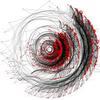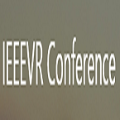Conducting collaborative tasks, e.g., multi-user game, in virtual reality (VR) could enable us to explore more immersive and effective experience. However, for current VR systems, users cannot communicate properly with each other via their gaze points, and this would interfere with users' mutual understanding of the intention. In this study, we aimed to find the optimal eye tracking data visualization , which minimized the cognitive interference and improved the understanding of the visual attention and intention between users. We designed three different eye tracking data visualizations: gaze cursor, gaze spotlight and gaze trajectory in VR scene for a course of human heart , and found that gaze cursor from doctors could help students learn complex 3D heart models more effectively. To further explore, two students as a pair were asked to finish a quiz in VR environment, with sharing gaze cursors with each other, and obtained more efficiency and scores. It indicated that sharing eye tracking data visualization could improve the quality and efficiency of collaborative work in the VR environment.
翻译:在虚拟现实(VR)环境中进行协作任务,例如多用户游戏,可以使我们探索更具沉浸感和效果的体验。然而,在当前的 VR 系统中,用户无法通过他们的凝视点正确地相互交流,这将干扰用户对意图的相互理解。在本研究中,我们旨在找到最佳的眼动数据可视化,最小化认知干扰,提高用户对可视注意力和意图的理解。我们为人类心脏的一个过程设计了三种不同的眼动数据可视化:凝视光标、凝视聚光灯和视线轨迹,发现医生使用的凝视光标可以更有效地帮助学生学习复杂的 3D 心脏模型。为进一步探索,要求两个学生组成一对在 VR 环境中完成测验,并共享他们的凝视光标,结果显示获得更高的效率和分数。这表明共享式眼动数据可视化可以提高 VR 环境中协作工作的质量和效率。





